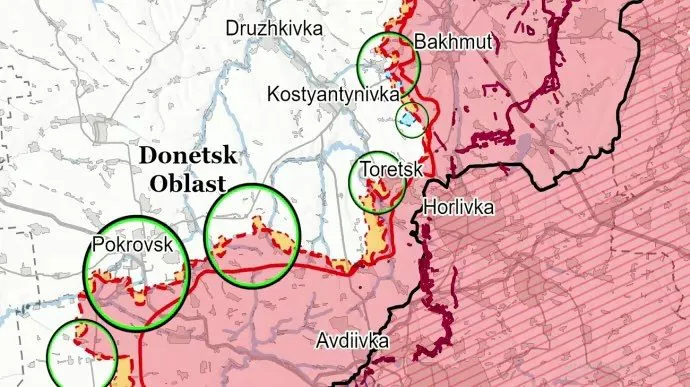“ISW analysts suggested how the Russian troops could use the advance to Toretsk. ISW analysts believe that without reinforcements from other areas of the front, the threat to the city will be insignificant.”, — write on: unn.ua
Details
The report notes that according to geolocation images released on January 6, the Russian military advanced along Kvitkova Street and reached the northwestern administrative border of Toretsk.
One of the Russian bloggers claims that Russian troops occupy approximately 90% of the city’s territory
However, according to geolocation maps studied by ISW analysts, as of January 7, Russian troops occupy approximately 71% of the territory of the settlement.
ISW suggests that Russian forces likely intend to use their successes in northwest Toretsk to advance west of Toretsk and Shcherbynivka and along the T-05-16 Toretsk-Kostyantinivka route towards the southernmost point of the Ukrainian fortification belt at Kostiantynivka.

According to analysts, the invaders may intend to gain a foothold in the northwest of Toretsk and in the center of Shcherbynivka (west of Toretsk) in order to advance along the T-05-16 route in the direction of Kostyantynivka through Nelipivka, Pleshchiivka, Ivanopil and the fields around these settlements. trying to create a threat to the southern edge of the Ukrainian fortification belt Kostyantynivka – Druzhkivka – Kramatorsk, which is the basis of the defense of the Donetsk region.
Russian troops may also try to use the further advance to the northwest of Toretsk and south of Chasovoy Yar in the direction of Bila Gora and Oleksandr-Shultyny in order to destroy the Ukrainian “pocket” in this area and align the front line west and southwest of Kostyantynivka .
Such an advance would complicate Ukraine’s ability to counterattack in Russia’s near rear to the southeast of Chasovoy Yar, including in the direction of Klishchiivka, and would allow Russian forces to deploy additional artillery systems within range of Kostiantynivka and use FPV drones within range of the city
Russian troops may also try to advance west and northwest of New York and Leonidivka in the direction of highways N-20 Donetsk – Kostiantynivka and H-32 Pokrovsk – Kostiantynivka, in order to squeeze Kostiantynivka from the south and create a more stable southern flank for the offensive on Kostyantynivka.
Experts note that Russian forces will likely be able to advance faster in the fields and small settlements north and west of Toretsk than they were able to achieve in their slow advance toward the city of Toretsk.
Russian army units in the area may try to repeat the short, tactically important mechanized attacks they conducted on the Kurakhiv and Vugledar directions in the fall of 2024, if they have a sufficient reserve of armored vehicles for this sector.
Russian forces may try to use tactical gains in and near Toretsk, as well as east of Pokrovsk, to eliminate Ukrainian fortifications southwest of Toretsk. They may try to use gains within Toretsk and in the Toretsk-Scherbinivka-New York section, as well as recent Russian gains east of Pokrovsk, to eliminate the Ukrainian “pocket” between Vozdvizhenka (east of Pokrovsk) and Toretsk.
According to ISW, the Russian advance east of Pokrovsk and west of Toretsk may be part of an ongoing effort to gain advantages that allow the capture of any territory, despite its relative insignificance.
At the same time, according to experts, Russian troops are unlikely to pose a significant threat to Kostyantynivka, unless the Russian military command reinforces the existing grouping of troops in the area with troops from other frontline areas.
the Russian military command may continue to give priority to the Pokrovsky and Kurakhiv directions, but reduce the priority of offensive operations in other areas of the front, such as the Kupyansky or Borivsky directions, in order to redeploy forces to the Toretsky direction
“At this time, ISW is not ready to provide a forecast on how the Russians will distribute efforts under Toretsk.”
ISW Key Findings for January 7:
Russian troops advanced into Toretsk after several weeks of more rapid offensive operations and gaining new positions in the area.
The occupiers likely intend to use their successes in Toretsk to advance west of Toretsk and Shcherbynivka and along the T-05-16 Toretsk-Kostyantynivka route towards the southernmost point of the Ukrainian fortification belt at Kostyantynivka.
Russian troops may try to use tactical advantages in and near Toretsk, as well as east of Pokrovsk, to eliminate Ukrainian fortifications southwest of Toretsk.
They are likely to try to break out of Toretsk’s urban encirclement and push into more open rural areas, similar to those where Russian forces have made significant gains elsewhere on the front in recent months.
Russian forces are unlikely to pose a significant threat to Kostiantynivka unless the Russian military command reinforces the existing troop grouping in the area with troops from other areas of the front.
The Ukrainian General Staff said that on January 7, Ukrainian troops attacked the command post of the Russian 810th Marine Brigade in Beliya, Kursk Oblast of the Russian Federation.
Ukrainian troops have recently advanced in the Kursk region, and Russian troops have advanced near Kupyansk, Toretsk, Pokrovsk and in the Kursk region.
The Kremlin continues to promote the “Heroes’ Time” program, which aims to appoint veterans of the full-scale Russian invasion of Ukraine to positions in local, regional and federal government.
We will remind
The invaders continue their offensive in the east of Ukraine, occupying several settlements. Among them are Lozova, Ivanivka and Shevchenko. In addition, fighting continues in Toretsk, where the enemy has advanced, but the line of contact remains under clarification.
